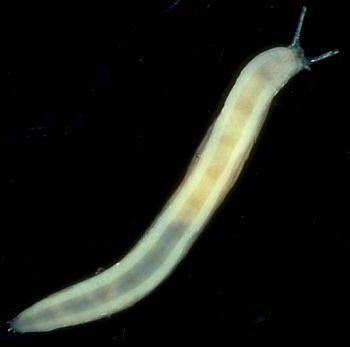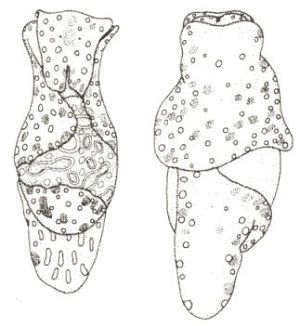

How sea slugs crawl
PHOTO
Upper: Sole of land slug Limax gagates [55mm long] showing tranverse bands of contracted muscle.
Lower: Haminoea cymbalum showing posterior 'pseudofoot'. Photo & Drawings: Bill Rudman.
Most gastropods (marine snails, land snails and slugs, and sea slugs) have a muscular foot which is used from crawling. The foot produces a sticky mucus and has a coating of fine cilia. Some very small snails seems to slide along on their mucous secretion simply by the beating of their cilia, but in most gastropods transverse waves of muscular contraction move along the foot, from the posterior to the anterior end. These waves form temporary points of attachment which effectively pull the snail/slug along. I have included a photo of the foot of a land slug, Limax gagates from my garden. It clearly shows the foot is a complex structure with a thick band around the edge which remains in permanent contact with the ground and a median band which only makes contact as the transverse wave of contraction moves past. The darker bands are the waves. The nature of the wave differs in different families, some have waves right across the foot, others have the foot divided down the middle with an alternate left and right wave travelling along the foot. One of life's little mysteries is why the silvery trails on the footparh are sometimes continuous and sometimes a series of patches. You can see that this slug is always in contact with the ground so it is responsible for a continuous trail while the common garden snail Helix aspersa, which doesn't have a permanent muscle band around the edge, produces a dotted trail.
Before I forget that this is a Sea Slug Forum, lets look at them in particular. Most nudibranchs have a muscular foot which can be modified for particular situations. In species which live on soft sand, like Cerberilla the foot is very broad and ciliary gliding predominates over muscular waves, while in large dorids forward movement is almost totally dependent on the wave of muscle contraction. Many animals which live in potentially perilous places, such as a branching hydroid or alga in a strong current, have specialised pedal glands which produce a particularly sticky mucus so they retain a hold on their substrate.
In many cephalaspid bubble shells the true foot is lost or very reduced, and they have a secondary foot developed from the posterior mantle flap. Species of Haminoea show a half-way situation [see drawing above]. In the aglajids this secondary foot is apparently all that is present, and in aglajids [Chelidonura, Philinopsis etc] locomotion is totally produced by ciliary gliding on a bed of mucus produced by enormous glands at the anterior end. Some sacoglossans have a transverse groove across the foot just behind the head, suggesting to me that the part of the foot behind the groove is also a secondary foot.
One side-effect of producing a mucous trail is that nudibranchs, and other sea slugs advertise their whereabouts at all times. Carnivores such as Navanax inermis and species of Roboastra rely on this tell-tale trail to find their prey. It is also apparently useful in the peculiar 'trailing' behaviour of species of Risbecia.
Some sea slugs swim. This behaviour has evolved independently many times within the opisthobranchs. When I get a chance I will prepare a separate page on swimming.
Authorship detailsRudman, W.B., 2001 (May 23) How sea slugs crawl. [In] Sea Slug Forum. Australian Museum, Sydney. Available from http://www.seaslugforum.net/find/locomotion
Related messages
Detecting slime
September 26, 2002
From: Laura Richards
Hello there!
can you help? I am researching slug slime for a BBC TV documentary! Has anyone ever discovered how to spot slime under a UV light or anything? We're trying to make the invisible visible here ... Any help gratefully received.
Laura
laura.richards@bbc.co.uk
Richards, L., 2002 (Sep 26) Detecting slime. [Message in] Sea Slug Forum. Australian Museum, Sydney. Available from http://www.seaslugforum.net/find/8000Dear Laura,
I understand that Dr Mark Davies, University of Sunderland, is an expert on snail/slug slime. Perhaps you should try him
Email: mark.davies@sunderland.ac.uk
Best wishes,
Bill Rudman
Re: Snail's slime
June 26, 2002
From: Cynthia Trowbridge
Dear Earl and Bill,
A colleague of mine in the UK, Mark Davies, has written numerous papers on gastropod mucus. Here is a partial list of publications. I am sure that the last reference listed would include everything you wanted to know about mucus but were afraid to ask.
• Holmes, S. P., Sturgess, C. J., Cherrill, A, & Davies, M.S. (2001) Shell wiping in Calliostoma zizyphinum (L.): the use of pedal mucus as a provendering agent and its contribution to the daily energetic requirements. Marine Ecology Progress Series, 212: 171-181.
• Davies, M.S., Beckwith, P. (1999) The role of mucus trails and trail-following in the behaviour and nutrition of the periwinkle Littorina littorea (L.). Marine Ecology Progress Series, 179: 247-257.
• Davies, M. S., Hawkins, S.J. (1998) Mucus from marine molluscs. Advances in Marine Biology, 34: 1-71.
Cordially,
Cynthia
trowbric@onid.orst.edu
Trowbridge, C., 2002 (Jun 26) Re: Snail's slime. [Message in] Sea Slug Forum. Australian Museum, Sydney. Available from http://www.seaslugforum.net/find/7356Thanks Cynthia,
Bill Rudman
Snail's slime
June 25, 2002
From: Earl Denzel Perez
I want to know what is the composition (preferably, the chemical composition) of a snail slime. That is because we need it in a science research. Thank you very much for the information.
Earl
early_mann@yahoo.com
Perez, E.D., 2002 (Jun 25) Snail's slime. [Message in] Sea Slug Forum. Australian Museum, Sydney. Available from http://www.seaslugforum.net/find/7346Dear Earl,
I don't think there is any easy answer to this. Mucus is a very complex substance containing complex molecules called mucopolysaccharides. At times it can also contain calcite crystals and I assume other things we don't know about. In fact the nature of the mucus changes on different parts of a snail's body, sticky and viscous on upper parts and thin and more fluid on the sole of the foot. Presumably different species have mucus with slightly different chemical makeup.
Sorry I can't help more, but there are many things in nature we know little about,
Best wishes,
Bill Rudman
How does a nudibranch foot work?
May 25, 2001
From: Valda Fraser
Dear Bill
I want to know about nudibranch locomotion and have searched your General Topics section without success. Can you explain how the foot is used? For instance, do the foot muscles initiate movement? Is there mucus? Are there cilia on the under-surface? Thanks.
Regards
Valda Fraser
valdafraser@mweb.co.za
Fraser, V., 2001 (May 25) How does a nudibranch foot work?. [Message in] Sea Slug Forum. Australian Museum, Sydney. Available from http://www.seaslugforum.net/find/4374Dear Valda,
It's one of the gaps in the General Topics list that I have been planning to fill. I have prepared a Locomotion Page. I hope that answers your question. If not, let me know
Cheers,
Bill
